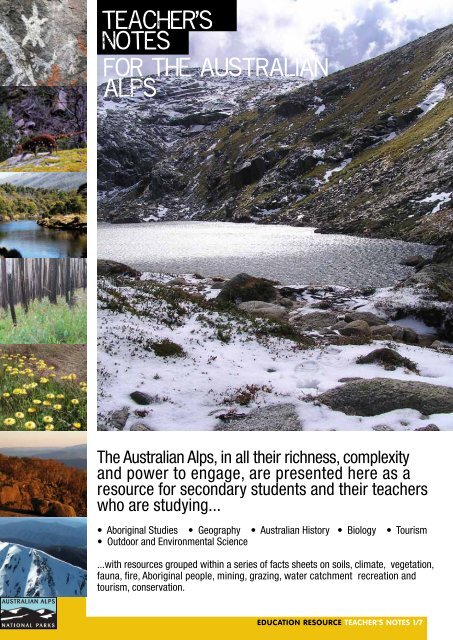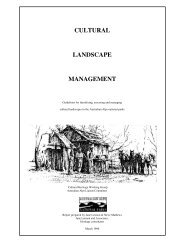The Australian Alps Education Kit - Australian Alps National Parks
The Australian Alps Education Kit - Australian Alps National Parks
The Australian Alps Education Kit - Australian Alps National Parks
- No tags were found...
Create successful ePaper yourself
Turn your PDF publications into a flip-book with our unique Google optimized e-Paper software.
teacher’snotesMathematics: To increase spatial awareness, examine how Aboriginal people understoodthe relationships between seasons, directions, temperature and the sun in the <strong>Australian</strong><strong>Alps</strong> to enhance special awareness. Build a timeline of known events associating Aboriginalpeople with the <strong>Australian</strong> <strong>Alps</strong>.Science: Research methods used to prepare food, such as Bogong Moths.Studies of Society and Environment: Explore the relationship that different Aboriginal peoplehad and have with the <strong>Australian</strong> <strong>Alps</strong>. Examine how Aboriginal people’s artwork in the<strong>Australian</strong> <strong>Alps</strong> reflects the relationship that they had and have with the <strong>Australian</strong> <strong>Alps</strong>.Technology: Examine the aesthetic and functional use of everyday natural source materialof Aboriginal people in the <strong>Australian</strong> <strong>Alps</strong>.Year 7 to 10 Studies of Society and Environment: Natural and social systemsDescribe and analyse natural changes that have taken place in the <strong>Australian</strong> <strong>Alps</strong> over time.Year 7 to 10 Studies of Society and Environment: Time, continuity and changeExamine the history of the Snowy Mountain Scheme and identify how it contributed to the<strong>Australian</strong> identity and to identity change. Consider heritage and tradition of the <strong>Australian</strong><strong>Alps</strong> and identify what is and has been valued from the past by different groups and peopleat different times.Year 11 and 12 History A Unit: Contemporary AustraliaExamine the development of the Snowy Mountains Scheme and provide a description of thetechnological and social changes that took place as a result of the Scheme.Unit: <strong>Australian</strong> History Research UnitInvestigate the development of the <strong>Australian</strong> <strong>Alps</strong> national park (or a park within the <strong>Australian</strong><strong>Alps</strong>, such as Tidbinbilla Nature Reserve) and identify historic, cultural, environmental,social and political changes that have taken place over time.Year 11 and 12 BiologyUnit: Interdependence - Nature of ecosystems and relationships existing within themInvestigate sub-alpine and alpine ecosystems in terms of the physical environment, andplant and animal communities. Describe the relationships that exist within these ecosystems.Unit: Human impact - Human interactions with the environment; conservation, recyclingand pollutionInvestigate the human interactions that take place in alpine areas of the <strong>Australian</strong> <strong>Alps</strong> andidentify the significance of these interactions.Year 11 and 12 Geography A/T course- Unit: Australia’s biophysical environmentDevelop an <strong>Australian</strong> <strong>Alps</strong> case study describing the biophysical features (atmosphere,climate, landforms, drainage, fauna, vegetation and soils), impacts on the <strong>Alps</strong>’ natural resourcesand management strategies for the conservation of these natural resources.EDUCATION RESOURCE TEACHER’S NOTES 3/7
teacher’snotesUnit: Earth in actionInvestigate the <strong>Australian</strong> <strong>Alps</strong> or a specific area within the <strong>Australian</strong> <strong>Alps</strong>, in terms of itslandform characteristics, water catchment and drainage. Describe any climatic changes,weathering processes, changes in soil and vegetation over time. Identify ways in whichpeople, over time, have used and/or changed the <strong>Australian</strong> <strong>Alps</strong> and describe steps that havebeen taken to reduce impacts.Unit: Tourism perspectiveExamine tourism in the <strong>Australian</strong> <strong>Alps</strong>, identifying the geographical features and factors thatdetermine the nature of tourism in the <strong>Alps</strong>, the environmental, social, cultural and economicissues associated with tourism in the <strong>Australian</strong> <strong>Alps</strong> and the management decisions thathave been undertaken to reduce the impacts of tourism.Unit: Fragile ecosystemsAnalyse ecosystems within the <strong>Australian</strong> <strong>Alps</strong> national parks and describe the classification,productivity, factors affecting the functioning of the ecosystems, impacts due to natural stressand impacts due to human factors.Study and describe the ecosystems of the <strong>Australian</strong> <strong>Alps</strong> and discuss the reasons for theprotection of ecosystems.Unit: Geographic research projectA number of issues arise from the <strong>Australian</strong> <strong>Alps</strong>’ complex uses. Consider one or more ofthese issues and through research, field studies and analysis of data (such as maps, graphs,statistics, interviews and photographs) discuss the issue in relation to biophysical and socialchanges and impacts.Year 11 and 12 Outdoor <strong>Education</strong>Outdoor <strong>Education</strong> A and T/VocationalSeveral units of work within the Outdoor <strong>Education</strong> course could be conducted through fieldwork in the <strong>Australian</strong> <strong>Alps</strong> national parks including bushwalking leadership, downhill skiing,snowboarding, cross country skiing, back country skiing, snow: environment and recreation,caves, cliffs and canyons and the bush recreation and environment units.Unit: Field Studies in Natural HistoryThrough a field study to alpine and sub-alpine areas within the <strong>Australian</strong> <strong>Alps</strong>, record observationsand describe selected habitats and any human impact on these habitats. Record andrecommend any minimum impact conservation measures observed or required.Year 11 and 12 TourismUse the <strong>Australian</strong> <strong>Alps</strong>, or an area within the <strong>Australian</strong> <strong>Alps</strong>, to:research and document the sources and destination information required, including generalproduct information, about the <strong>Australian</strong> <strong>Alps</strong>; gather, analyse and access specific tourismproduct information about the <strong>Australian</strong> <strong>Alps</strong>; research information on the Australia <strong>Alps</strong>for presentation to customers; outline the need for on going research to update and expandthe knowledge that a guide in the <strong>Australian</strong> <strong>Alps</strong> would require. For example, investigate anarea within the <strong>Australian</strong> <strong>Alps</strong> - e.g. Namadgi <strong>National</strong> Park or Tidbinbilla Nature Reserve- and document information that is required to respond to general customer informationrequests. Access and interpret information on current activities, to provide assistance to customersand promote the attraction.EDUCATION RESOURCE TEACHER’S NOTES 4/7
teacher’snotesNew South Wales curriculumYear 7 to 10 Aboriginal StudiesStage 4: Investigate the ways that Aboriginal people interact with the <strong>Australian</strong> <strong>Alps</strong> over time.Stage 5: Describe the relationships Aboriginal people have with the <strong>Australian</strong> <strong>Alps</strong>.Year 7 to 10 Geography (Elective and Mandatory)Mandatory, Stage 4: Identify and gather geographical information about the <strong>Australian</strong> <strong>Alps</strong>.Mandatory, Stage 4: Examine and discuss the geographical processes that have formed andtransformed the <strong>Australian</strong> <strong>Alps</strong>.Year 7 to 10 History (Elective and Mandatory)Stage 4: Identify through research, significant features of Aboriginal culture in the <strong>Australian</strong><strong>Alps</strong> prior to colonisation. Stage 5: Trace the history of cattlemen in the <strong>Australian</strong> <strong>Alps</strong> and thechanges that have taken place as a consequence of changes to land management.Year 11 and 12 Geography – Ecosystem at Risk<strong>The</strong> <strong>Australian</strong> <strong>Alps</strong> provides an example of an ecosystem for a case study of an ecosystem ‘atrisk’. It could also be the subject for a senior geography project. <strong>The</strong> case study requires theidentification of alpine characteristics including: spatial patterns and dimensions (location, altitude,latitude, size, shape and continuity); interaction of the four spheres (atmosphere,lithosphere, hydrosphere and biosphere) the dynamics of weather and climate; bio-geographicalprocesses (invasion, succession, modification, resilience, adjustments in response to naturalstress); the nature and rate of change which affects ecosystem functioning; human impacts(both positive and negative); and traditional and contemporary management practices.Year 11 and 12 Aboriginal Studies Unit: Heritage and identityResearch and develop understandings about the connections that a specific Aboriginal grouphas with the <strong>Australian</strong> <strong>Alps</strong>. This can be achieved through interviews, web searches, examinationof artwork and written documentation. Document broader aspects of Aboriginal heritage andidentity including relationships with land, ownership of culture, history and knowledge. Identifyand discuss the influences and impacts on identity over time.Year 11 and 12 TourismUse the <strong>Australian</strong> <strong>Alps</strong>, or an area within the <strong>Australian</strong> <strong>Alps</strong>, to: research and document thesources and destination information required, including general product information, about the<strong>Australian</strong> <strong>Alps</strong>; gather, analyse and access specific tourism product information about the <strong>Australian</strong><strong>Alps</strong>; research information on the Australia <strong>Alps</strong> for presentation to customers; outline theneed for on going research to update and expand the knowledge that a guide in the <strong>Australian</strong><strong>Alps</strong> would require. For example, investigate an area within the <strong>Australian</strong> <strong>Alps</strong> and documentinformation that is required to respond to general customer information requests. Access andinterpret information on current activities, to provide assistance to customers and promote theattraction.EDUCATION RESOURCE TEACHER’S NOTES 5/7
teacher’snotesVictorian curriculumYear 7 to 10 Geography, Studies of Society and Environment,(Level 5, 5.1) Compare the characteristics of the <strong>Australian</strong> <strong>Alps</strong> with those of another alpineregion in another part of the world. Describe, compare and contrast physical characteristics,and present maps and statistics as part of the analysis explaining why these alpine areasexhibit certain characteristics.(Level 6, 6.4) Develop a comprehensive strategy to resolve an issue relating to the use andmanagement of the <strong>Australian</strong> <strong>Alps</strong>.Year 11 and 12 <strong>Australian</strong> History Unit: Koorie HistoryTrace the changes and continuities in Koorie relationships with land in the <strong>Australian</strong> <strong>Alps</strong>.Year 11 and 12 Geography Unit: Place and changeDocument the geographical characteristics of the <strong>Australian</strong> <strong>Alps</strong>. Drawing from a number ofdifferent information and data sources, describe changes that have taken place in the <strong>Australian</strong><strong>Alps</strong> as a result of natural processes and human processes.Year 11 & 12 Outdoor and Environmental ScienceUnit: Environmental impactsResearch and collect information from a variety of sources about the <strong>Australian</strong> <strong>Alps</strong> (or anarea within the <strong>Australian</strong> <strong>Alps</strong>) that illustrate and document the variety of outdoor experiencesthat are possible. Analyse motivations for seeking outdoor experiences, the technologyrequired, commercialisation of experiences, impacts on human and natural resources andways in which risk can be reduced when undertaking specific outdoor experiences.Unit: Relationships with outdoor environmentsInvestigate the relationship between the <strong>Australian</strong> <strong>Alps</strong> (or an area within the <strong>Australian</strong> <strong>Alps</strong>)and different peoples’ experience over time. Consider the <strong>Alps</strong> prior to or without humanhabitation and various outdoor experiences in the <strong>Australian</strong> <strong>Alps</strong>, including Aboriginal people,European settlers and modern outdoor experiences. Discuss the impacts, perceptions andchanges that have taken place with outdoor environment.Unit: <strong>The</strong> future of natural environmentsInvestigate the conflicts of interests that are evident within the <strong>Australian</strong> <strong>Alps</strong> (or an areawithin the <strong>Australian</strong> <strong>Alps</strong>), such as tourism and nature conservation, and the different strategiesand management plans that have been put in place to respond to these interests.Document the importance of these interests to individuals, society, organisations or specificgroups. Examine different ways that other parks and conservation areas in Australia and otherparts of the world have responded to competing interests.EDUCATION RESOURCE TEACHER’S NOTES 6/7
















